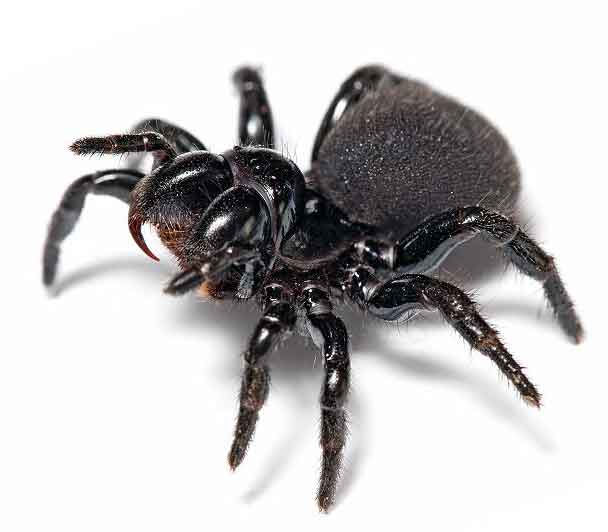
Missulena bradleyi (*)
Superregnum: Eukaryota
Cladus: Unikonta
Cladus: Opisthokonta
Cladus: Holozoa
Regnum: Animalia
Subregnum: Eumetazoa
Cladus: Bilateria
Cladus: Nephrozoa
Cladus: Protostomia
Cladus: Ecdysozoa
Cladus: Panarthropoda
Phylum: Arthropoda
Subphylum: Chelicerata
Classis: Arachnida
Ordo: Araneae
Subordo: Opisthothelae
Infraordo: Mygalomorphae
Superfamilia: Migoidea
Familia: Actinopodidae
Genus: Missulena
Species: Missulena bradleyi
Name
Missulena bradleyi Rainbow, 1914
References
Primary references
Rainbow, W.J. 1914: Studies in Australian Araneidae. No. 6. The Terretelariae. Records of the Australian Museum, 10: 187–270 [15 Aug. 1914] [268 pl. 9].
Additional references
Rash, L.D. et al. 2000: Neurotoxic activity of venom from the Australian Eastern mouse spider (Missulena bradleyi) involves modulation of sodium channel gating. British journal of pharmacology, 130(8): 1817–1824. DOI: 10.1038/sj.bjp.0703494
Missulena bradleyi, also known as the eastern mouse spider, is a species of spider belonging to the family Actinopodidae. The spider is endemic to the eastern coast of Australia.[2][3]
History
William Joseph Rainbow described the eastern mouse spider in 1914 from a specimen collected in North Sydney by Henry Houghton Burton Bradley (1845–1918), president of the board of trustees of the Australian Museum at the time. Describing the "beautiful and strikingly marked" specimen as a "decided novelty", Rainbow named it in honour of its collector, whom he stated was the first collector of Australian spiders.[4]
Description
Female specimen in a model burrow on display in the Australian Museum
Eastern mouse spiders are often mistaken for Australian funnel-web spiders.[5] The females are large and very strong, with powerful chelicerae.[6] Their fangs often cross over slightly, while those of Australian funnel-web spiders remain parallel,[3] and the latter often have a drop of venom on their fang tips and have longer spinnerets.
Males have a trapezium-shaped lighter patch that can be coloured from white and pale blue to mauve while females have abdomens that are coloured brown to almost black. Both sexes have a carapace that is a shiny black colour.[7]
Behaviour
The male, which has an all-black carapace and a pale bluish area on top of the abdomen,[6] roams around in autumn and early winter looking for a mate.[8] They sometimes fall into swimming pools when wandering.[9] Cases of envenomations have peaked during this period.[10]
The burrow can be found by brushing away loose soil in an area where they live until a flap of silk indicative of the entrance is found.[6]
Eastern mouse spider in The Gap, Brisbane
Envenomation
Common symptoms of eastern mouse spider bites are numbness and tingling at the bite site, sweating (diaphoresis), headache, and nausea generally. Although it appears to be the most dangerous member of the genus, serious envenomations by this species are relatively rare. Most bites documented in the medical literature did not require use of antivenom nor involve serious symptoms.
Severe envenomation occurred in only one case, a 19-month old child, who developed high blood pressure, muscle spasms, arched back, and unconsciousness. The child responded well to funnel-web spider antivenom. Their venom has been found to have toxins similar to the robustoxin found in Australian funnel-web spider venom, and Australian funnel-web spider antivenom has been found to be effective in treating severe mouse spider bites. Compared to the Australian funnel-web spider, however, the eastern mouse spider is far less aggressive towards humans, and may often give "dry" bites.[10][11]
References
"Taxon details Missulena bradleyi Rainbow, 1914". World Spider Catalog. Natural History Museum Bern. Retrieved 15 March 2016.
"Mouse Spiders". Australian Museum. Retrieved 19 June 2013.
"Mygalomorphae or primitive spiders". Retrieved 19 June 2013.
Rainbow, William Joseph (1914). "Studies in Australian Araneidae. No. 6. The Terretelariae". Records of the Australian Museum. 10: 187–270 [268–70]. doi:10.3853/j.0067-1975.10.1914.901.
"Mouse Spiders". Australian Museum. Retrieved 4 Jan 2017.
Missulena bradleyi Rainbow, 1914 Bradley's Mouse Spider http://www.arachne.org.au/01_cms/details.asp?ID=2587
Rash, Lachlan D.; Birinyi‐Strachan, Liesl C.; Nicholson, Graham M.; Hodgson, Wayne C. (2000). "Neurotoxic activity of venom from the Australian Eastern mouse spider (Missulena bradleyi) involves modulation of sodium channel gating". British Journal of Pharmacology. 130 (8): 1817–1824. doi:10.1038/sj.bjp.0703494. ISSN 1476-5381. PMC 1572261. PMID 10952670.
Australian Reptile Park (2010). "Mouse Spider". The Hands On Zoo. Somersby, New South Wales: self. Retrieved 6 September 2013.
Queensland Museum (2013). "Mouse Spiders". Animals of Queensland. South Brisbane, Queensland: Queensland Government. Retrieved 6 September 2013.
Isbister, Geoffrey K (2004). "Mouse spider bites (Missulena spp.) and their medical importance". Medical Journal of Australia. 180 (5): 225–27.
"Identifying Spider Bites (Recluse, Widow, Wolf) + Treatment". SelfDecode Health. 2019-10-30. Retrieved 2022-07-01.
Retrieved from "http://en.wikipedia.org/"
All text is available under the terms of the GNU Free Documentation License

